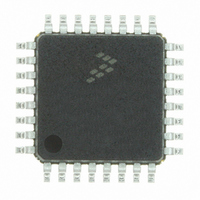MC56F8011VFAE Freescale Semiconductor, MC56F8011VFAE Datasheet - Page 80

MC56F8011VFAE
Manufacturer Part Number
MC56F8011VFAE
Description
IC DIGITAL SIGNAL CTLR 32-LQFP
Manufacturer
Freescale Semiconductor
Series
56F8xxxr
Datasheet
1.MC56F8013VFAE.pdf
(126 pages)
Specifications of MC56F8011VFAE
Core Processor
56800
Core Size
16-Bit
Speed
32MHz
Connectivity
I²C, SCI, SPI
Peripherals
POR, PWM, WDT
Number Of I /o
26
Program Memory Size
12KB (6K x 16)
Program Memory Type
FLASH
Ram Size
1K x 16
Voltage - Supply (vcc/vdd)
3 V ~ 3.6 V
Data Converters
A/D 6x12b
Oscillator Type
Internal
Operating Temperature
-40°C ~ 105°C
Package / Case
32-LQFP
Product
DSCs
Data Bus Width
16 bit
Processor Series
MC56F80xx
Core
56800E
Numeric And Arithmetic Format
Fixed-Point
Device Million Instructions Per Second
32 MIPs
Maximum Clock Frequency
32 MHz
Number Of Programmable I/os
26
Data Ram Size
2 KB
Operating Supply Voltage
3.3 V
Maximum Operating Temperature
+ 105 C
Mounting Style
SMD/SMT
Development Tools By Supplier
MC56F8037EVM, DEMO56F8014-EE, DEMO56F8013-EE
Interface Type
SCI, SPI, I2C
Minimum Operating Temperature
- 40 C
For Use With
CPA56F8013 - BOARD SOCKET FOR MC56F8013APMOTOR56F8000E - KIT DEMO MOTOR CTRL SYSTEM
Lead Free Status / RoHS Status
Lead free / RoHS Compliant
Eeprom Size
-
Lead Free Status / Rohs Status
Lead free / RoHS Compliant
Available stocks
Company
Part Number
Manufacturer
Quantity
Price
Company:
Part Number:
MC56F8011VFAE
Manufacturer:
Freescale
Quantity:
1
Company:
Part Number:
MC56F8011VFAE
Manufacturer:
Freescale Semiconductor
Quantity:
10 000
The power modes provide additional means to disable clock domains, configure the voltage regulator, and
configure clock generation to manage power utilization, as shown in
modes provide means of enabling/disabling the peripheral and/or core clocking as a group. Stop disable
controls are provided for selected peripherals in the control register so that these peripheral clocks can
optionally continue to operate in Stop mode and generate interrupts which will return the part from Stop
to Run mode. Standby mode provides normal operation but at very low speed and power utilization. It is
possible to invoke Stop or Wait mode while in Standby mode for even greater levels of power reduction.
A 200kHz clock external clock can optionally be used in Standby mode to produce the required Standby
100kHz system bus rate. Power-down mode, which selects the ROSC clock source but shuts it off, fully
disables the part and minimizes its power utilization but is only recoverable via reset.
When the PLL is not selected and the system bus is operating at around 100kHz, the large regulator can
be put into its Standby mode (LRSTDBY) to reduce the power utilization of that regulator.
80
Wait
Stop
Standby
Power-Down
Mode
Table 6-3 Clock Operation in Power-Down Modes (Continued)
Core and memory
clocks disabled
Master clock generation in the OCCS
remains operational, but the SIM disables
the generation of system and peripheral
clocks.
The OCCS generates the 2X system clock
at a reduced frequency (200kHz). The PLL
and high speed peripheral clocks are
disabled and the high-speed peripheral
option is not available. System and
peripheral clocks operate at 100kHz.
Master clock generation in the OCCS is
completely shut down. All system and
peripheral clocks are disabled.
Core Clocks
56F8013/56F8011 Data Sheet, Rev. 12
Peripheral clocks
enabled
Peripheral Clocks
Core executes WAIT instruction to enter this
mode.
Typically used for power-conscious applications.
Possible recoveries from Wait mode to Run
mode are:
1. Any interrupt
2. Executing a Debug mode entry command
during the 56800E core JTAG interface
2. Any reset (POR, external, software, COP)
Core executes STOP instruction to enter this
mode. Possible recoveries from Stop mode to
Run mode are:
1. Interrupt from Timer channels that have been
configured to operate in Stop mode (TCx_SD)
2. Interrupt for SCI configured to operate in Stop
mode (SCI_SD)
3. Low-voltage interrupt
4. Executing a Debug mode entry command
using the 56800E core JTAG interface
5. Any reset (POR, external, software, COP)
The user configures the OCCS and SIM to select
the relaxation oscillator clock source (PRECS),
shut down the PLL (PLLPD), put the relaxation
oscillator in Standby mode (ROSB), and put the
large regulator in Standby (LRSTDBY). The part
is fully operational, but operating at a minimum
frequency and power configuration. Recovery
requires reversing the sequence used to enter
this mode (allowing for PLL lock time).
The user configures the OCCS and SIM to enter
Standby mode as shown in the previous
description, followed by powering down the
oscillator (ROPD). The only possible recoveries
from this mode are:
1. External Reset
2. Power-On Reset
Table
Description
6-3. Run, Wait, and Stop
Freescale Semiconductor











